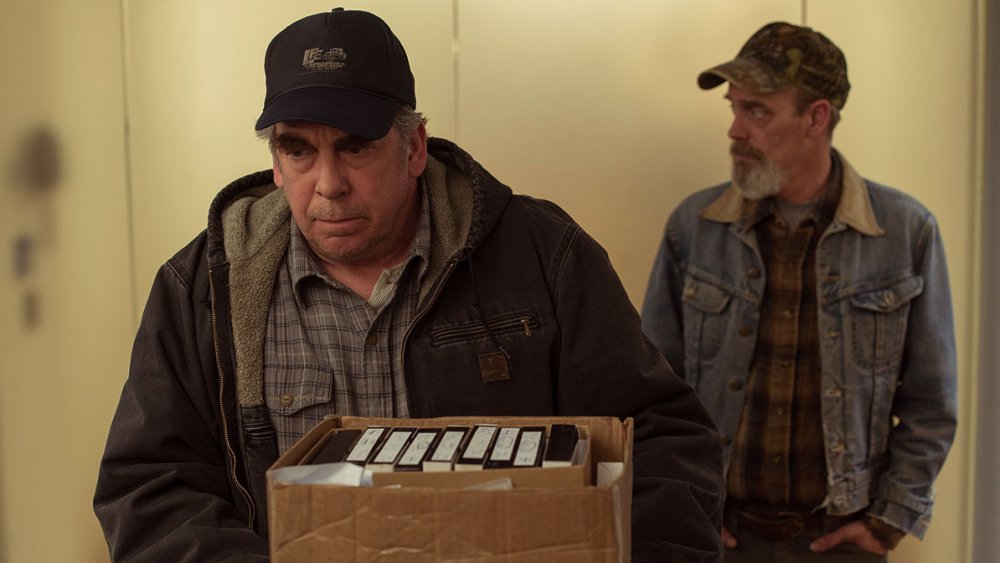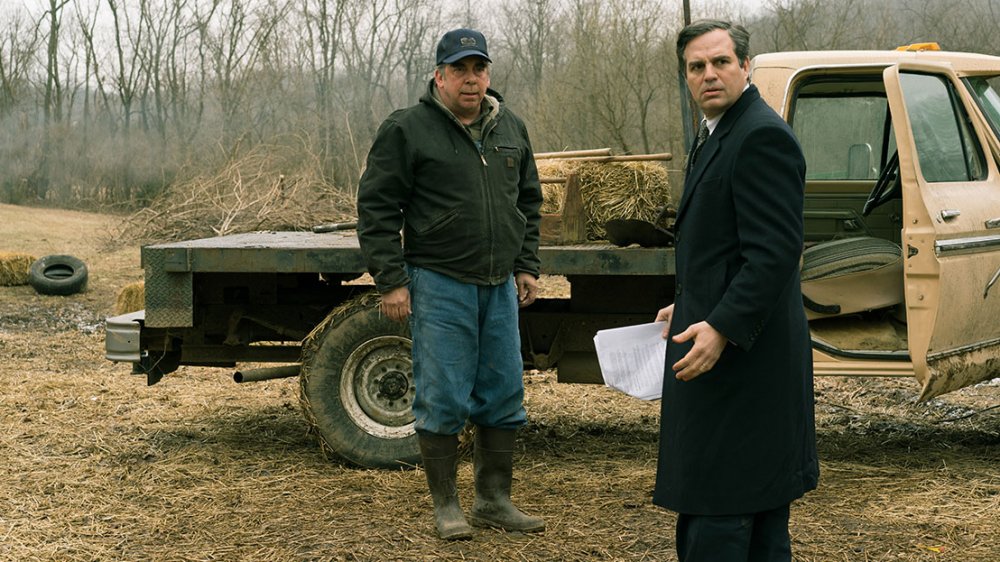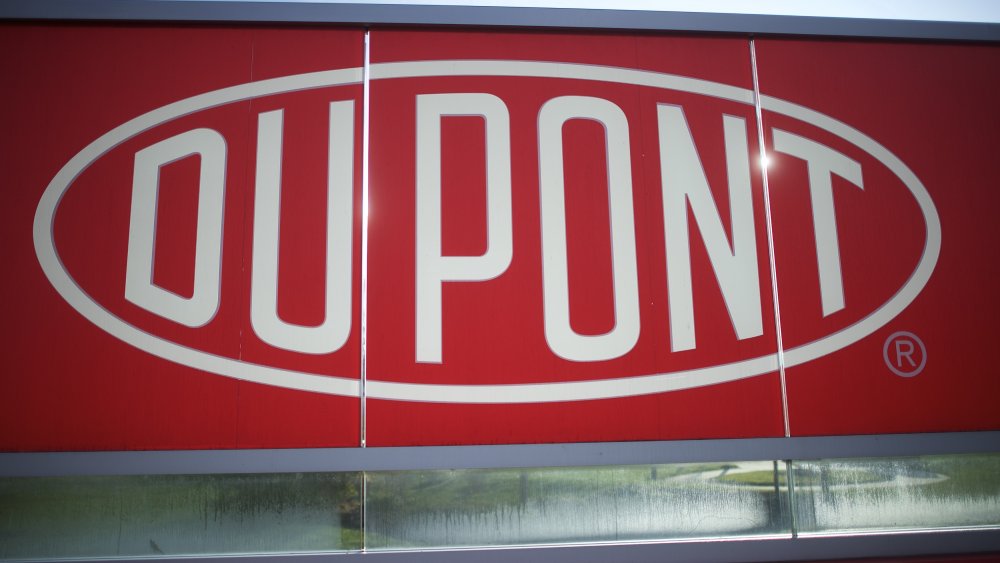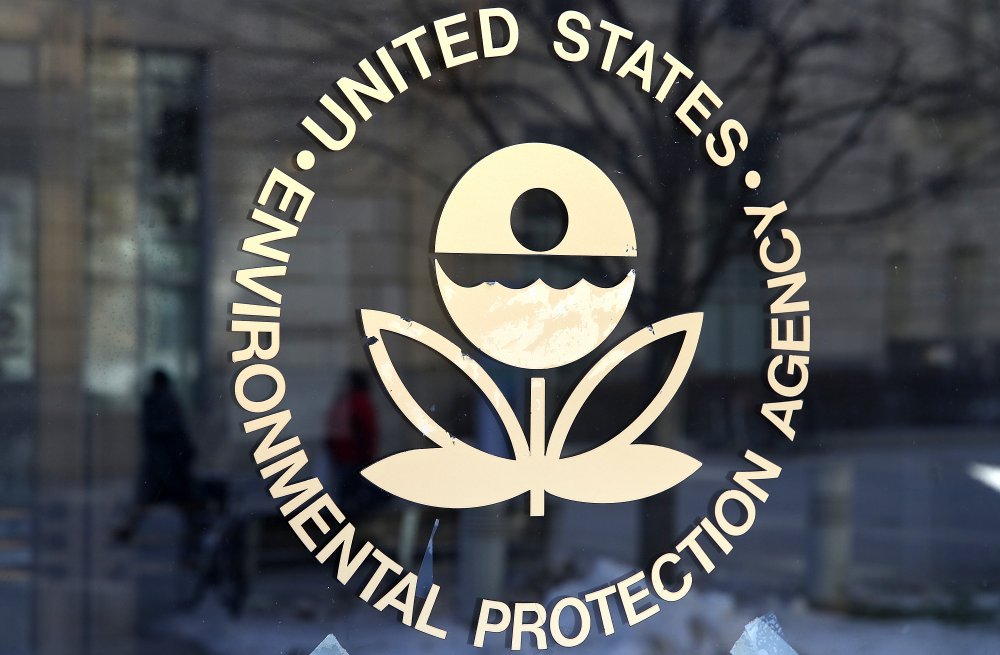The Messed Up True Story Behind Dark Waters
It's a story straight out of a legal thriller penned by John Grisham, though instead of the Deep South, this one takes place in Appalachia. And, like many Grisham novels, it's a tale worthy of the big screen.
The underdog was a farmer whose family worked the land for generations, building it from a small operation to a thriving livelihood. He suspected one of his town's largest employers was up to no good, allegedly dumping chemicals and contaminating his farm's water supply, and the result was hundreds of sickened and dead cattle. The unlikely hero was an Ohio-based corporate defense lawyer paid to protect chemical companies, just like the one the farmer suspected of foul play. Turns out his grandmother lived in the same town as the farmer ... and that's the connection that brought the underdog and the hero together. Their quest for justice wound its way through the American judicial system for nearly two decades, unearthing long-hidden deeds which, some reports say, are akin to those perpetrated by big tobacco on the public.
And if it sounds familiar, it should. It's the messy, real story behind Focus Features' Dark Waters movie, starring Mark Ruffalo as Robert Bilott, the corporate lawyer turned environmental activist who led an epic legal fight against chemical titan DuPont. Dark Waters' messed up true story reveals an emerging public health and environmental threat, the pervasiveness of "forever chemicals," and an alleged corporate cover-up.
The dark waters of Parkersburg
The story started in Parkersburg, West Virginia, home to about 32,000 people and about a three-hour drive due east of Cincinnati. Much like many river cities, Parkersburg's history speaks of a working class, industrial heritage, which saw companies set up shop on the shores of the Ohio River, bringing jobs and economic stability. Around here, that economic engine was DuPont, known for innovations like nylon, Tyvek, and Teflon. DuPont established a presence along the Ohio River in 1948 with the Washington Works plant near Parkersburg. Today, that site is home to Chemours Washington Works, a spinoff of DuPont that employs more than 600 people and produces a variety of products used in construction, aerospace, and household goods.
Parkersburg is also home to the Tennant family, who, for nearly a century, have worked land that eventually grew to 700-plus acres and raised more than 200 head of cattle. Wilbur Earl Tennant and his siblings took over the land when their father abandoned them in the 1950s, according to the Huffington Post. Wilbur's brother, Jim, was also employed as a laborer at the Washington Works plant, along with hundreds more who found steady work at the area's largest employer. In the 1980s, Jim and his wife, Della, would sell acreage to DuPont for use as a landfill for scrap metal, according to the New York Times Magazine.
In time, the connection between the Tennants and DuPont would run as deep as the Ohio River.
Why won't anyone listen to Wilbur Tennant?
By the late 1990s, West Virginia farmer Wilbur Tennant was at his wits end. His pleas for help fell on deaf ears, according to the Huffington Post's article, "Welcome to Beautiful Parkersburg, West Virginia." He was certain that DuPont was fouling the waters that his cattle drank, and he'd already lost more than half of his herd to bizarre illnesses.
Tennant recounted to anyone who would listen that he'd lost about 100 calves and 50 cows over the years. No matter how much he fed them, they always looked to be wasting away, and some even bled from their mouth as they bellowed, according to the New York Times Magazine. Tennant and his brother Jim wanted to get to the bottom of it, so they dissected some carcasses. "As soon as you cut the skin loose, you get some of the foulest smells you've ever smelled," Jim Tennant told the Huffington Post. "The innards was bright green."
They were green like the foamy water that ran out of a pipe from the nearby Dry Run Landfill and into the creek from which the Tennant cattle drank. That's just some of the video footage Wilbur showed lawyer Robert Bilott, according to an excerpt from Exposure: Poisoned Water, Corporate Greed, and One Lawyer's Twenty-Year Battle against DuPont. And after Bilott watched and listened, he took action.
The lawsuit at the heart of Dark Waters begins
Bilott's connection to Parkersburg dated back to his childhood, when he spent summers there visiting his grandmother, and her friend is the one who suggested to Wilbur Tennant that he call Bilott, an environmental lawyer at Cincinnati firm Taft Stettinius & Hollister, for help.
Bilott helped companies comply with new environmental regulations established by the Superfund legislation and became an expert at the chemistry of pollutants, according to the New York Times Magazine. He started the legal process in 1999 against DuPont by filing motions compelling it to turn over documents pertaining to hazardous materials used at the Washington Works plant near Parkersburg. "He was doing for the Tennants what he would have done for any of his corporate clients — pulling permits, studying land deeds and requesting from DuPont all documentation related to Dry Run Landfill — but he could find no evidence that explained what was happening to the cattle," the New York Times wrote.
In 2000, Bilott found notations on an internal DuPont document that referred to a chemical called perfluorooctanoic acid (PFOA), also known as C8, in Dry Run Creek. He requested all documents that DuPont had related to PFOA. DuPont initially refused, but a court order ultimately forced them to turn over what amounted to more than 100,000 pages, some dating back 50 years.
It's not just the cows getting sick
In the 1980s, Jim Tennant and his wife, Della, got an offer from DuPont. The local employer wanted to buy some of their property for a landfill for its Washington Works plant nearby, where it produces, among other things, Teflon, which contains the chemical C8. The Tennants were initially reluctant, especially because of its intended use, but DuPont promised it would house only nonhazardous waste, like scrap metal and ash, according to the Huffington Post. So, the couple sold about 60 acres to DuPont. And the money came in handy, too, since Jim, a Washington Works employee, had for years suffered from flu-like symptoms and illnesses that baffled doctors, as outlined in a Delaware Online article from 2016.
According to the New York Times Magazine, "By 1990, DuPont had dumped 7,100 tons of PFOA sludge into Dry Run Landfill. DuPont's scientists understood that the landfill drained into the Tennants' remaining property, and they tested the water in Dry Run Creek. It contained an extraordinarily high concentration of PFOA. DuPont did not tell this to the Tennants at the time." Once this came to light, reports indicate, the Tennants settled their lawsuit against DuPont in August 2000, but the fight wasn't over.
A pattern emerges
Ken Wamsley spent nearly 40 years working at DuPont Washington Works plant, and some of that time, he measured levels of the chemical C8 (PFOA). He told The Intercept in 2015 that it bubbled up out of glass containers and "was everywhere." Wamsley suffered from ulcerative colitis, a condition that can lead to rectal cancer, which, in his case it, did.
Sue Bailey was pregnant when she worked in the Teflon division of the plant. Her son, Bucky, was born in 1981 with nose and eye deformities. When she returned to work at DuPont, Bailey learned about a study by 3M (the manufacturer of C8) that found similar deformities in unborn rats exposed to the chemical, according to the Huffington Post. Per the article, "In March 1981, DuPont sent a pathologist and a birth defects expert to review the 3M data Bailey had read about in the locker room. They concluded that 'the study was valid' and that 'the observed fetal eye defects were due to C8,' according to internal DuPont documents. DuPont immediately removed all female workers from areas where they might come into contact with the chemical."
Shorty after that, DuPont started to medically monitor female workers at the Washington Works plant to, as the company's medical director noted, "answer a single question — does C8 cause abnormal children?" Initial data showed evidence that it did. However, the company didn't tell employees or regulators and ended the study, the Huffington Post reports.
A clear and present danger
Teflon came into prominence in the 1940s, and with it came DuPont's rise as a chemical giant. A key component of Teflon was C8, also known as perfluorooctanoic acid (PFOA). C8 is a "surfactant," a chemical compound that reduces surface tension. C8 and other long-chain per-fluorinated chemicals are used in a myriad of household, industrial, and commercial products. Up until about a decade ago, few in the public knew about C8, let alone its potential health effects, but DuPont allegedly knew its toxic effects for decades and purportedly failed to tell employees or the public, according to The Intercept.
DuPont bought C8 from 3M and used it to prevent Teflon from clumping during the manufacturing process. The substance is stable, persistent, and very difficult to break down. "Though PFOA was not classified by the government as a hazardous substance, 3M sent DuPont recommendations on how to dispose of it. It was to be incinerated or sent to chemical-waste facilities. DuPont's own instructions specified that it was not to be flushed into surface water or sewers," according to the New York Times Magazine.
In April 2000, after 3M conducted tests and studies on a similar, sister chemical to C8 (PFOA) called PFOS, the company notified the Environmental Protection Agency it found that "even modest exposure could have devastating health effects" and started to phase out PFOS use, as well as PFOA, according to the Huffington Post.
The paper trail
Details of what DuPont allegedly knew and when came to light in pages and pages of documents, initially as part of the lawsuit Bilott filed against the company on behalf of Wilbur Tennant and then in more than 3,000 subsequent personal injury suits that have followed in the past two decades. The Intercept notes that the legal process "uncovered hundreds of internal communications revealing that DuPont employees for many years suspected that C8 was harmful and yet continued to use it, putting the company's workers and the people who lived near its plants at risk."
By the 1980s, DuPont had allegedly begun dumping PFOA waste into the Dry Creek Landfill, near the Tennant property. DuPont also discovered that pollution containing PFOA vented from the Washington Works plant affected the surrounding area, allegedly contaminating the local water supply, according to the New York Times Magazine. "In 1991, DuPont scientists determined an internal safety limit for PFOA concentration in drinking water: one part per billion. The same year, DuPont found that water in one local district contained PFOA levels at three times that figure. Despite internal debate, it declined to make the information public," the magazine notes.
Bilott found studies that potentially linked PFOA with a variety of cancers, birth defects, and illnesses. Even though the Tennant case had already settled, Bilott pushed on, building a larger case against DuPont on behalf of residents in a Parkersburg-area water district.
DuPont responds to Dark Waters
In November 2019, the Washington Post hosted a podcast with Mark Ruffalo and Robert Bilott to discuss the film and the lawsuit. The Post read a statement from DuPont that reiterated the company's commitment to health and safety and protecting the environment: "Although DuPont does not make the chemicals in question, we have announced a series of commitments around our limited use of PFAS and are leading [the] industry in supporting federal legislation and science-based regulatory efforts to address these chemicals." DuPont's statement said the film "depict[s] wholly imagined events," calling implications of a cover up "inaccurate," and claimed that it "grossly misrepresents" what happened. "We have always and will continue to work with those in the scientific, not-for-profit and policy communities who demonstrate a serious and sincere desire to improve our health, our communities, and our planet."
DuPont settled the Tennant case for an undisclosed amount. In 2005, the company agreed to fund studies on the health effects of C8. The same year, the EPA fined DuPont more than $10 million for "failing to report 'substantial risk of injury to human health' from C8 (PFOA)," according to The Intercept. And in 2017, according to Reuters, DuPont and its spinoff, Chemours, agreed to pay more than $600 million to settle about 3,500 personal injury resulting from the alleged contamination of local water supplies in Parkersburg. Both companies denied any wrongdoing.
The chemicals in Dark Waters are called 'forever chemicals'
PFOA (C8) and PFOS were the long-chain, more commonly used substances in a larger group of more than 4,000 man-made chemicals called per- and polyfluoroalkyl substances (PFAS). PFAS are ubiquitous. They're in virtually everything we use, including stain-resistant fabric and carpets, nonstick cookware, water-repellent clothing, and firefighting foam. And, based on Centers for Disease Control data, PFAS chemicals were found the blood of 98 percent of people studied.
These emerging contaminants linger, breaking down only when incinerated at very high temperatures. "PFASs are extremely persistent in the environment primarily because the chemical bond between the carbon and fluorine atoms is extremely strong and stable," according to the Environmental Protection Agency. During manufacturing processes, PFAS chemicals are released into the air, soil, and water around industrial facilities, the EPA reports. These chemicals are most harmful when ingested and consequently bioaccumulate, meaning they build up over time in the body (just as they build up in the environment).
Studies have found potential links between PFOA exposure and high cholesterol, thyroid disorders, and testicular and kidney cancers, according to the Centers for Disease Control and the Agency for Toxic Substances and Disease Registry. ATSDR/CDC also notes that more studies need to be done in the area of health effects, particularly on shorter-chain substances. In 2005, DuPont agreed to phase out its use of C8 (PFOA) by 2015, according to The Intercept.
What's being done about the public health threat exposed in Dark Waters?
These "forever chemicals" are an emerging global health and environmental issue. In May 2015, a consortium of scientists across many disciplines released a document called the Madrid Statement. The document, published in Environmental Health Perspectives, called on global scientists, manufacturers, and retailers to work together to limit the use of PFASs and develop safer alternatives. The US House of Representatives passed a bill in January 2020 that would require the EPA to deem per- and polyfluoroalkyl substances (PFAS) hazardous and establish a national drinking water standard.
The EPA on its own only recently started to take steps to study, monitor, and regulate the use of PFAS and released an update to its action plan program in February 2020. The federal agency notes that it has made significant progress in addressing the public health concerns "from issuing groundwater cleanup guidance to proposing a positive regulatory determination for both PFOA and PFOS, EPA has made progress under every aspect of the Action Plan."
Some states aren't waiting for the feds to act, taking steps to hasten a response to "forever chemicals" through mitigation and regulation, and some of those steps include court action. For example, New Hampshire sued 3M and DuPont, along with a handful of companies that make firefighting foam containing PFAS. The suit alleges negligence claiming the chemicals contaminated the state's natural resources, according to New Hampshire Public Radio.
The Dark Waters story continues
Robert Bilott isn't done. In October 2018, he filed a lawsuit on behalf of a firefighter, who used fire suppression foam and equipment containing PFAS for 40 years. Bilott is seeking class-action status in the case against several companies, including 3M and Chemours. The suit, rather than seeking compensation, requests that the companies fund independent, scientific studies on the health effects of PFAS, according to Time Magazine. "If we can't get where we need to go to protect people through our regulatory channels, through our legislative process, then unfortunately what we have left is our legal process," Bilott told Time in November 2019. "If that's what it takes to get people the information they need and to protect people, we're willing to do it."
In a statement to Time, DuPont said it does not produce PFAS but does use them and defended the company's environmental and safety record, noting it has "announced a series of commitments around our limited use of PFAS, including the [sic] eliminating the use of all PFAS-based firefighting foams from our facilities." The other companies named in the lawsuit did not respond to Time's requests for comment.
Dark Waters tells a story that in many ways is still being written, and it will likely take years for this latest lawsuit to be resolved. And the man who started it all, Wilbur Tennant, won't see that resolution. He died of cancer in 2009.











